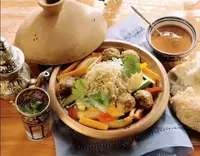The tunisian

Tunisian cuisine is a fabulous kaleidoscope of tastes, smells and sensations. In the recipes of Tunisian cuisine, everything was mixed - East with West, Arabs and French, Asian and European traditions.
Tunisia is on the Mediterranean coast in northern Africa. The ancient great state of Carthage was located in the modern territory of Tunisia.
Carthage fell under the pressure of Roman warriors and became part of another mighty empire - Roman. The Romans were driven out of Carthage by the Turks of the Ottoman Empire. Around the same time, the first Arab settlements appeared on the territory of Tunisia.
At the end of the 19th century, Tunisia became a French colony. Such a rich history was reflected not only in the multinational culture and traditions of Tunisia, but also in the dishes of Tunisian cuisine. The indigenous people themselves will not remember that from the recipes of Tunisian cuisine they got from the Turks, Arabs, Spaniards or French.
Each new owner of the Tunisian territories brought something extraordinary and individual to the culinary traditions of the locals. The people of Tunisia are very sensitive and respectful of food. The Tunisian meal has a special place in the routine of any local resident.
Food is not customary to consume on the go, so fast food is not particularly popular with the local population. In Tunisia, it is customary for the whole family to gather at the same table and eat fresh, freshly cooked food.
You will often hear the phrase "eat and do not spare your belly" in Tunisia. This statement absolutely accurately reflects the attitude towards food of the indigenous people of the country. It is believed that Tunisian dishes should first of all saturate the body, so they are nutritious and healthy.
Often, out of habit, travelers order national soups from Tunisian restaurants, which chefs are used to serving in large portions. The second dishes of Tunisian cuisine also differ in their gigantic size. Therefore, it is not surprising that after a large plate of hearty soup, it is simply unrealistic to fit whole baked fish with spices or a hearty stew of lamb in a pot in your stomach.
Thanks to the French, Tunisia has a special additional meal cascut from the French casse- croûte, which literally translates as "light breakfast. " Usually, a Tunisian lunch in the French manner consists of only one dish of Tunisian cuisine - a sandwich. Crispy French baguette works beautifully with fresh salad, canned tuna, sausage, fried chicken breast, olives, tomatoes and harissa.
The main recipe for Tunisian cuisine for any hostess is the only correct, special and her own culinary recipe for making kus kusa. In Tunisian cuisine, there are simply an incredible number of recipes for making couscous. Also, the recipes of Tunisian cuisine are characterized by the use of a large amount of seasonings, spices and spicy herbs.
For a snack in Tunisia, you can sample harissa - this is a paste of burning red pepper, which is supplemented with olive oil. In Tunisia, they love a variety of vegetable or fish salads. For example, Omak Huria canned tuna salad with vegetables and olives.
Tomato-based soups are the most popular in Tunisia. A traditional soup for the Tunisian cuisine of Shorba: it is made with meat, fish or vegetables. Among the hot snacks can be distinguished a dish called Brick. This is cheburek in Tunisian, in which, in addition to fish, potatoes, eggs, herbs are added and the filling is wrapped in a dough sheet, which is deep-fried.
Tunisian cuisine is also famous for its sweets, in which fruits, nuts and berries will be the main ingredients. Tunisian confectioners add pistachios, walnuts or pine nuts to the dough base, very often almonds, all this is poured with honey and the famous Tunisian sweets are obtained - Baklava, Mlabes, Kaaber. Green tea with various flavors will be a great addition to eastern desserts.
 Español
Español Français
Français Português
Português Русский
Русский 简体中文
简体中文 繁體中文
繁體中文 日本語
日本語 한국어
한국어 العربية
العربية Türkçe
Türkçe Қазақ
Қазақ Deutsch
Deutsch Italiano
Italiano Українська
Українська
